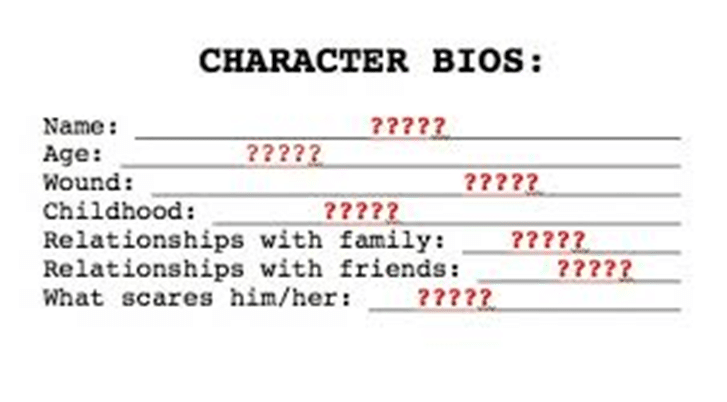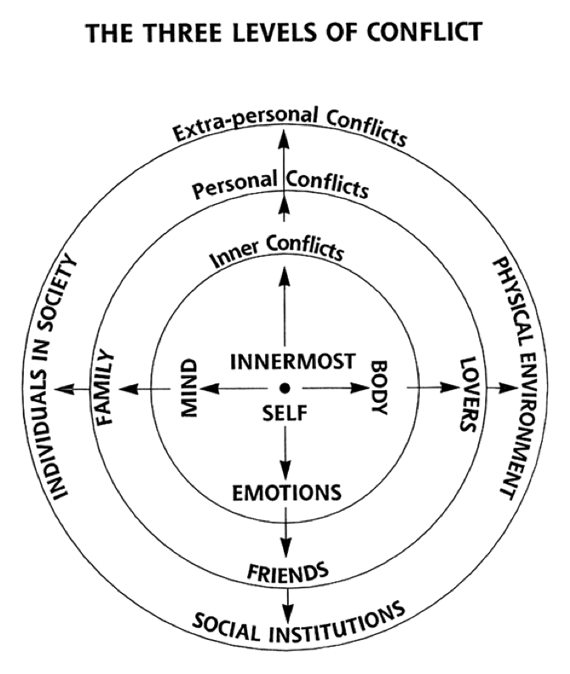Table of Contents
- Creating Characters: A Daunting Process
- 1. Determine Your Character’s Role in the Story
- 2. Get to Know your Character from the Inside out
- 3. Establish your Character’s Individual Point of View
- 4. Each Character Must Have an Attitude
- 5. The Lie the Character Believes
- 6. Your Character’s Ghost
- 7. Determine What Your Character Wants
- 8. Determine What Your Character Needs
- 9. Something has to Stand in their Way
- 10. Make Your Characters Take Action
- 11. The Tactics and Strategies at your Character’s Disposal
- 12. It Should be a Matter of Life and Death, or more Important than that
- 13. Determine your Character’s Personal Qualities
- 14. Establish Your Character’s Relationships
- 15. At Last, Everything Must Change
- In Summary
Creating Characters: A Daunting Process
When writing a screenplay, the process of creating characters can be so arduous yet so enlightening, so varied yet at the same time so individually unique, that simply trying to define how to do it is like trying to catch smoke.
How do you craft multi-dimensional characters that will wow industry executives? How do you make an audience invest in your characters and their journeys? Can you move past writing lifeless caricatures and cardboard cut-outs to writing characters so well-developed that they seem to spring to life off the page?
Whether you’re a novice screenwriter taking your first steps towards that ever-elusive first draft or a seasoned pro, developing your fifth feature, there is always one immutable fact: Characters are the driving force of your story. If your characters are not compelling then your screenplay is going nowhere.
Therefore, before you first put pen to paper (or more likely finger to keyboard), it may benefit you to learn these 15 essential steps for creating characters.
1. Determine Your Character’s Role in the Story
Before you can effectively create a character, you must determine the role they will play in your story. Will they serve as a protagonist or an antagonist? Are they a lead character or a supporting character?
To differentiate between the two, a lead character will:
- appear in nearly every scene
- drive the plot
- need a complex backstory and three-dimensional personality
Whereas a supporting character will:
- either support or hinder the lead characters
- appear multiple times throughout the course of the story
- have a short backstory
A useful tool to determine what function your character then plays in the plot is character archetypes. There are numerous examples of archetypes in fiction, each with their own specific role in the plot and defining set of universal, recognizable behaviours that can be used as a blueprint for creating characters.
Archetypes exist because each represents a part of our own minds, just turned into a character. Through them, we can experience how to solve problems in our own lives.
Using characters from the original Star Wars trilogy, examples of major character archetypes include:
- The Hero (Luke Skywalker)- will play a major role in completing the goal, wants to succeed.
- The Wise Elder (Obi-Wan)- eldest of the group, mystical/mysterious, provides guidance to hero.
- The Adventurer (Han Solo)- confident, risk-taker, leader.
- The Sidekick (C3PO & R2D2)- average, comedic, provides support to the hero, complements hero.
- The Villain (Darth Vader)- wants hero not to succeed, dishonest, violent/evil intentions.

2. Get to Know your Character from the Inside out
Audiences demand a strong understanding of who your characters are. They want to know why they take the actions they do in your screenplay.
If someone was to ask you the question, “what was your character’s childhood like?” and your response is a five-second pause followed by the first answer that pops into your head, it shows that your character is not fully developed. However, worst still, it shows that you don’t know who your characters are.
Creating successful characters means first digging into their past and present. It means getting to know them from the inside out. This goes beyond deciding their name, age, sex and appearance to establishing your character’s life.
Separate the components of their life into two basic categories:
A Character’s Life: Interior and Exterior
- Interior- the interior life of your character takes place from when they are born to the moment your screenplay fades in.
Interior life builds character.
Trace your character’s life until the story begins. Ask questions and examine their upbringing, relationships, careers, dreams, hopes and aspirations. Before you know it you will not only see your character start to form, you will also see the emotional forces working on your character.
- Exterior- the exterior life of your character takes place from the beginning of your screenplay to the final fade-out.
Exterior life is the process of revealing character.
Divide this aspect of your character into three further categories.
- Their professional life, what does your character do for a living?
- Personal life, is your character in a relationship when the story begins?
- Private life, what does your character do when they’re alone?
This process is extremely beneficial because these aspects of your character have the potential for becoming subplots, secondary actions or simply something to move the story forward.
There are several ways to approach creating your characters interior and exterior lives. You must choose the best way for you. The most popular of this is the character biography (or interview). This gives you the opportunity to sit down with your character and answer questions pertaining to their interior/exterior lives.

Remember, film is a visual medium. It is important to reveal your characters visually and you cannot reveal what you do not know. You need to move past thinking of the character as a notion or idea in your head to revealing them on paper.
After all, if you don’t understand who your characters are, how they’ve lived and where they have been, then how could you possibly be able to speak with their own unique voices?
3. Establish your Character’s Individual Point of View
Every person that has ever existed is unique and the same can be said for every character. They are all created differently with their own individual points of view. This defines the way the character sees, or views, the world.
“You either die a hero or live long enough to see yourself become the villain”.
The Dark Knight
“Life is like a box of chocolates, you never know what you’re gonna get”.
Forrest Gump
Both of these famous lines are expressions of character’s unique points of views, grown from their own personal experiences. So, think of your characters’ lives and think about how they might influence their independent belief systems.
If your character is a war hero adjusting to civilian life then they could reflect a “veteran’s” point of view. Or maybe they are a bank robber and therefore they could reflect a “criminal’s” point of view.
Creating characters with different points of view not only becomes a great way to generate conflict it also provides an avenue into the exploration of your screenplay’s theme.
Characters’ Points of View in Jurassic Park
Just look at the characters of John Hammond and Dr Grant in Jurassic Park (which explores themes of progress) as an example:
John Hammond – After accumulating a vast entertainment empire and having more money than God, John decides he can use his considerable resources to bring dinosaurs back to life.
This character is so focused on progress that he does not even think that genetically engineering dangerous dinosaurs is a bad idea. He has been created with his singular point of view: move forward at all costs. This is summed up perfectly by his infamous catchphrase “spared no expense”.
Dr Grant – On the other hand, Grant has spent most of his life digging up fossils, content on living in the past. Therefore, he has much more of an anti-progress mind-set. This is expressed through his hatred of computers and his mistrust of technology.
The second sign of his anti-progress view is that he is not compatible with a more symbolic representation of the future; his character does not like kids and does not want to have them.
4. Each Character Must Have an Attitude
This does not mean that every character you create has to be a cocky egomaniac with an attitude “problem”. An attitude defines your character’s manner or personal opinion and is a way of acting or feeling. How does my character really feel about themselves and others?
It is a judgement, does your character think they are always right or often wrong? Is your character optimistic or pessimistic? Does your character think they are a good person or a bad person? Either way, their behaviour and emotional reactions inherently stem from the attitude they personify.
For example, if your character thinks they are right all the time then they will feel superior to others around them and might react in such a way. Whereas creating a character who is mentally drained and physically hurt but is determined to fight on shows an attitude of heroism.
If point of view is the way your characters sees the world, then attitude is the way they see themselves. That in turn determines how they reach out and interact with the world.
5. The Lie the Character Believes
Wherever your character begins in your story, whether his life is horrible or his life seems pretty great, you need to make sure festering beneath the surface is a great lie. The lie is a specific belief that you should be able to state in a short sentence. It is a misconception that your character holds about themselves, the world, or most likely both.
In essence, you are giving them a character flaw.
Creating characters that are flawed helps your audience empathize with them, allowing them to see themselves within the character because ultimately no one is perfect. No one turns up to the cinema hoping to see an almighty god who knows all and is flawless in every way.
As you develop your characters further, you will inevitably generate new flaws and weakness that will help define your character. But the lie your character believes has to be so deeply rooted in their foundations that it directly hinders them and creates obstacles/conflict throughout the entire screenplay.
Your character’s lie could take on a variety of forms. For some quick examples, they may believe:
- I can control the new technology that I have discovered (Jurassic Park).
- Life is only worth living if you are the favourite (Toy Story).
- My criminal actions are justified if they are for my family (Breaking Bad).
- We must hide from the rest of the world to be safe (Black Panther).
The lie the character believes provides the character with something lacking in their life. It makes them incomplete in some way and fundamentally flawed because of this. This is what’s wrong with them or their world and once you know what’s wrong, you can then set about figuring how to make them right.

6. Your Character’s Ghost
Characters must have clear and plausible motivations that give insight into who they are and the actions they take. If there’s one main rule in fiction writing, it’s that every cause must have an effect.
Once you have figured out your character’s lie, the next step to creating characters is to ask the question, why does the character believe the lie in the first place? What happened to cause them to embrace this damaging flaw?
The best way to find the answer is to look for a ghost in your character’s past. “Ghost” is movie talk for something in your character’s past that haunts them; it may also be referred to as the “wound”.
You may choose to dramatize their motivations in the first act, like the death of Uncle Ben in the first Spider-Man. Alternatively, you may provide little clues that hint at your character’s ghost throughout the screenplay before presenting it in a final grand reveal. You may even shroud their past in secrecy so the audience never discovers their true motivations, like the Joker’s twisted stories about his scars in the Dark Knight.
Backstory is always one of the most interesting aspects of a character. It provides a tantalizing mystery for the audience. The why behind your character’s beliefs will hook the audiences’ curiosity. So pay special attention to ghosts.
7. Determine What Your Character Wants
After your character has been embedded with a lie and their motivations are established, the next logical step is to find the cure for the symptoms of that lie. What does your character want that they think will solve all their problems? What does your character wish to gain, win, get, or achieve through the course of the screenplay? Does your character have a specific goal?
Every story starts with the character’s goal. It’s their mission and purpose. It’s what drives your characters through the narrative. The thing the character wants will ultimately be something physical, something external. They believe if they get that new job or that new girlfriend then they will be fulfilled.
Making the character’s want an extension of their fundamental flaw is the best way to create a goal that is a reflection of something that matters to them on a deeper level, rather than just a simple story goal (or a surface goal). Looking back at the previous examples, the character might want to:
- Amaze people with the wonders that his technology has created (Jurassic Park).
- Be Andy’s favourite toy (Toy Story).
- Make enough money so his family is looked after (Breaking Bad).
- Be a good king (Black Panther).
There is absolutely nothing wrong with any of those (some of them are quite noble). However, these characters are pursuing goals that are furthering their own flaws to avoid facing the painful reality of their own lie.
But that’s not enough.
When creating characters that, even if only on the subconscious level, realise they have a problem that needs fixing, you must also be able to look past the thing they want and deep into the darkness of their souls to find the thing they need.
8. Determine What Your Character Needs
Essentially, the thing your character needs is the truth. It is the personalized antidote to their own irrefutable character flaw. The character’s need usually won’t be something physical, although it can take on a visual manifestation and usually should be physical by the end of the story. Never the less, your character’s need has to be nothing short of deep personal realization.
In the story, this realization will transform your character’s internal perspective of themselves and the world around them, thus making them more capable of coping with their external problems and conflicts. Determining whether or not your character will accept or reject this truth will allow them either to develop in a positive way, remain stuck in their current internal problem or digress into an even worse state.
The thing your character needs might be to:
- Learn that life finds a way and it cannot be controlled (Jurassic Park).
- Be able to share Andy’s love with others (Toy Story).
- Accept that his criminal endeavours are for his own selfish reasons (Breaking Bad).
- Follow his own path and make his own decisions (Black Panther).
As these examples show, these are all immaterial concepts. But they are things that can be demonstrated visually because they all act in direct opposition to the characters’ misconceptions and personal beliefs. They demand the characters must act upon them in some way.
Therefore, your character’s inner conflict is expressed through this silent war between the thing the character needs (the truth) and the thing the character wants (their perceived cure of the lie).
9. Something has to Stand in their Way
Creating characters with a goal on its own is not enough to create a story. If your character wants to save the world and nothing stops them, your story will be rather short and boring. Characters need to have obstacles in their way. They need to have conflict. Their conflicts must be interesting and must make sense, in order to raise the stakes in your plot and apply pressure to your character. To quote Robert McKee:
“True character is revealed in the choices a human being makes under pressure- the greater the pressure, the deeper the revelation, the truer the choice to the characters essential nature”.
The best obstacles are the ones that create the right mood, or emotion, or test your characters resolve to reveal the kind of people they really are. Therefore, the best way to generate conflict is to focus on a specific aspect of your character that you want to reveal, then create conflict that explores that trait.
Outlined below are the three levels of conflict that demonstrate how the forces of antagonism can grow from your character.
- Internal: where the thoughts, feelings or physical characteristics of a character block the achievement of their goal.
- Interpersonal: where relationships with other people or groups block the achievement.
- Extra-personal: where institutions, natural phenomenon and situations block the achievement.

10. Make Your Characters Take Action
It is important to remember that when you’re creating characters you must make them an active force in the screenplay. Whether they cause things to happen or whether things happen to them, they must take action.
Film is behaviour and because you’re telling a story through images, you must show how your character acts upon the incidents and obstacles that they confront and overcome.
Action is character; a person is defined by what they do not what they say. A character is expressed by who they are, by their actions and their creative choices.
Making your character an active force in the story stops them from simply reacting to incidents or events. If the character is always reacting, they become passive, weak, and that’s when the character seems to disappear off the page. A character’s passivity prevents them from making meaningful choices that reveal who they are as a character.
11. The Tactics and Strategies at your Character’s Disposal
Now that your character is taking action to achieve their goals, you also have to decide what strategies or tactics they utilize to do this. What tactics does your character employ when interacting with others to reach their objective? If their first tactic doesn’t work, what tactic do they switch to? After all, any goal without a plan of how to accomplish it is frankly just a dream or a longing.
A character’s tactics should relate directly to what’s going on inside them and reveal to the audience what emotional forces and internal beliefs are influencing these specific actions and strategies. In any given situation, a character should have tactics that they habitually do and tactics that they would never even contemplate doing.
As an example, your character might be a quiet person who tends to be polite and perhaps is a little too easily pushed around. This is revealed through your character’s approach to conflict, as they would most likely ask nicely and never make a fuss when confronted.
12. It Should be a Matter of Life and Death, or more Important than that
Ultimately, your character’s goal would not be complete if there is nothing serious at stake for them in your story. Attaining their goal must be the most important thing in the world for your character. If not, why should we care?
One sure-fire way of ensuring audiences are invested in your characters and the outcome of your plot is through careful consideration of your character’s stakes.
To define your character’s stakes, you need to answer the questions:
- What does your character stand to lose through the story’s central conflict?
- Vice versa- what do they stand to gain?
- What are they risking in trying to achieve their goal?
Looking at the character of Harry Potter as an example:
- Harry Stands to lose his own life, and the lives of his loved ones, through the central conflict with Voldemort.
- He stands to gain freedom for the wizarding world from the terrors of Voldemort’s potential reign.
- He risks his life and the lives of those closest to him in order to achieve his goal.

13. Determine your Character’s Personal Qualities
Once you have fully defined your character’s goal through their obstacles, tactics and stakes, you can now move on to establishing their personal qualities or as they are more commonly known – character traits. A trait is a distinguishing quality or characteristic that belongs to your character. What are their specific emotional, mental/social behaviours and idiosyncrasies that make up who they are?
These character traits can often be personified as strengths and weaknesses and every character should have both. Even if your character is your protagonist or your antagonist, it is important to remember that nobody is perfectly good, or perfectly evil. To quote from the previous example of Harry potter:
“We’ve all got both light and dark inside of us. What matters is the part we chose to act on, that’s who we really are”.
Every character will have positive and negative personality traits. Your character’s strengths have the opportunity to become valuable skills that they will later use in conflict. Your character’s weakness, meanwhile, can further develop their character flaws.
Making sure you’re creating characters with both provides them with layers to their personality, turning them into multi-dimensional constructs instead of caricatures that are essentially black or white.
14. Establish Your Character’s Relationships
In many ways, a character is defined as much by their relationships with others as they are their own personal traits. So it is important to examine the relationships in your character’s lives, as they have the potential of becoming a resource for greater depth of character.
Every screenplay has one or more relationship at the heart of it. Rarely can a character sustain a story on their own; a man or woman sitting alone in a house for ninety minutes makes for pretty boring cinema. Even stories that feature characters in isolation find ways to develop connections, think of Wilson the volleyball in Cast Away or the dog in I Am Legend.
Look to your character’s exterior life for inspirations for relationships and determine whether they may be in support of your character’s goal or against it for different reasons (which in turn could generate conflict).
Ask yourself:
- Do they share the same beliefs, or stand far apart on certain issues?
- What common bonds exist between these characters — do they share a history (good or bad), beliefs, common struggles, or needs?
- Do they have the same goal, competing goals, or do the goals conflict somehow?
Whether good, bad, past, or present, determining your character’s most important relationships can help audiences understand your character’s world better. Finding ways to illustrate and reveal them is a challenging reward.

15. At Last, Everything Must Change
This may be quite daunting to hear as the final essential step in creating characters. However, in reality it is essentially referring to your character’s arc throughout the screenplay. After your character has been carefully created with painstaking precision, it now falls to you to make something, or maybe even everything, about them change.
It could be a change in their personal beliefs, their circumstances or their goal. Either way, you have to decide early on if your character will change during the course of the screenplay. If so, what is that change? Can you trace the emotional arc of your character from beginning to end?
On the surface, a character’s arc will boil down to a three-step process:
- Your character starts out one way.
- The character learns some lessons throughout the story.
- Your character ends in a (probably) better place.
That is the character arc in a nutshell. Pretty easy right? What’s to learn? Turns out: a lot.
Luckily, we have created a separate article that provides you with an in-depth analysis on how to nail a character arc.
For the meantime, just remember, your character’s growth and evolution throughout your story is an essential part of creating characters as it allows the audience to feel closer to them, having witnessed their growth.
In Summary
There are multiple aspects that join together to form the foundations of a living breathing character before even the first letter of your screenplay hits the page. But the real key to creating characters lies in the way you choose to reveal them.
From their individual points of view that shape the way your character sees the world, to the internal struggle between what your characters want and what they really need, to the motivations that drive your character’s actions.
The process may be daunting but when you eventually find yourself speaking in your own character’s unique voice and you see them come to life, nothing can be more thrilling.
– What did you think of this article? Share It, Like It, give it a rating, and let us know your thoughts in the comments box further down…
– Struggling with a script or book? Story analysis is what we do, all day, every day… check out our range of script coverage services for writers & filmmakers.
This article was written by Stephen Harper and edited by IS Staff.
Get *ALL* our FREE Resources
Tackle the trickiest areas of screenwriting with our exclusive eBooks. Get all our FREE resources when you join 60,000 filmmakers on our mailing list!


Really enjoyed this. Thank you
Most welcome Pam!
Thanks a lot , Sir. Let me know about The Character Changing 🙏🙏🙏🙏💐💐💐💐